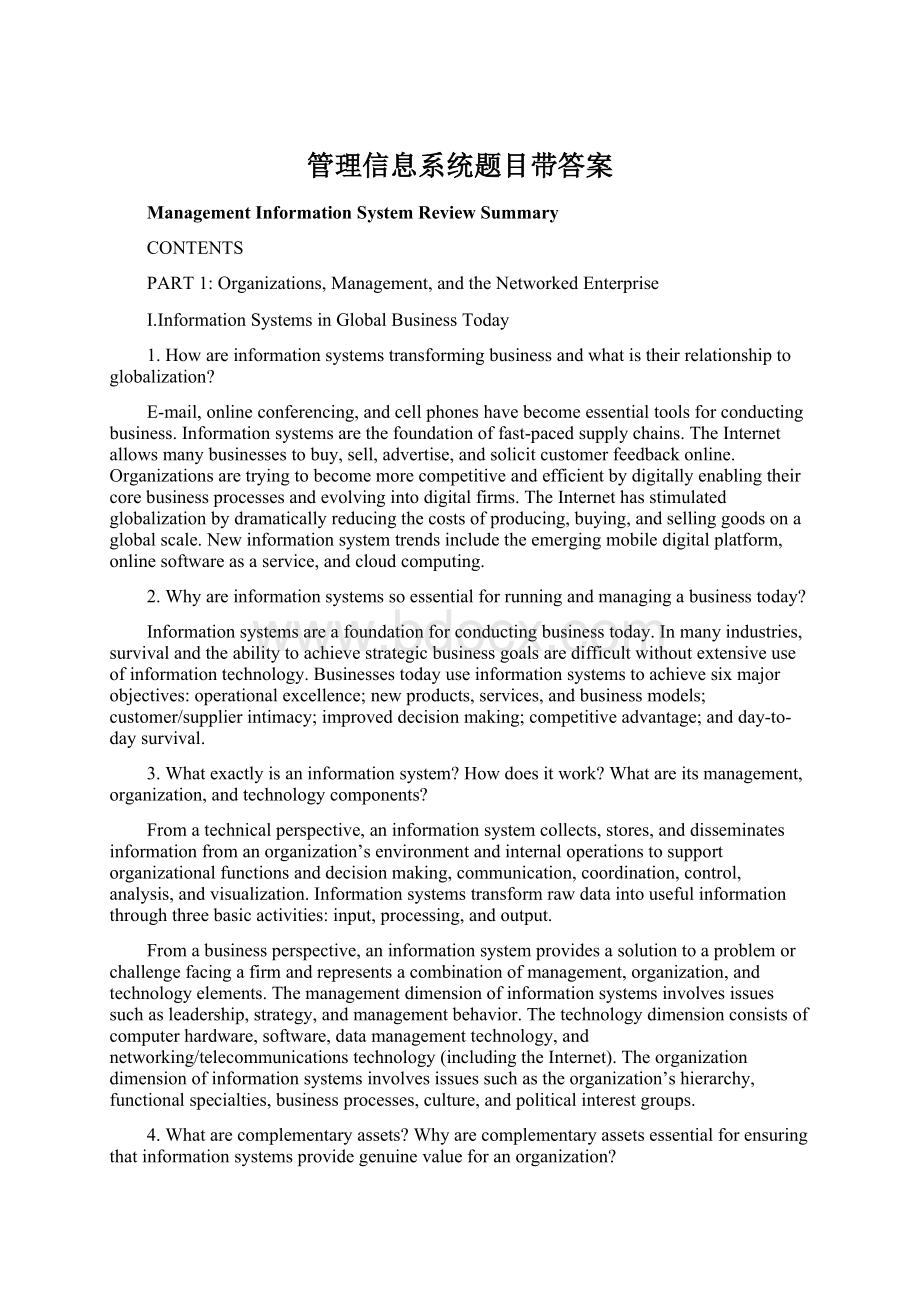管理信息系统题目带答案.docx
《管理信息系统题目带答案.docx》由会员分享,可在线阅读,更多相关《管理信息系统题目带答案.docx(19页珍藏版)》请在冰豆网上搜索。

管理信息系统题目带答案
ManagementInformationSystemReviewSummary
CONTENTS
PART1:
Organizations,Management,andtheNetworkedEnterprise
I.InformationSystemsinGlobalBusinessToday
1.Howareinformationsystemstransformingbusinessandwhatistheirrelationshiptoglobalization?
E-mail,onlineconferencing,andcellphoneshavebecomeessentialtoolsforconductingbusiness.Informationsystemsarethefoundationoffast-pacedsupplychains.TheInternetallowsmanybusinessestobuy,sell,advertise,andsolicitcustomerfeedbackonline.Organizationsaretryingtobecomemorecompetitiveandefficientbydigitallyenablingtheircorebusinessprocessesandevolvingintodigitalfirms.TheInternethasstimulatedglobalizationbydramaticallyreducingthecostsofproducing,buying,andsellinggoodsonaglobalscale.Newinformationsystemtrendsincludetheemergingmobiledigitalplatform,onlinesoftwareasaservice,andcloudcomputing.
2.Whyareinformationsystemssoessentialforrunningandmanagingabusinesstoday?
Informationsystemsareafoundationforconductingbusinesstoday.Inmanyindustries,survivalandtheabilitytoachievestrategicbusinessgoalsaredifficultwithoutextensiveuseofinformationtechnology.Businessestodayuseinformationsystemstoachievesixmajorobjectives:
operationalexcellence;newproducts,services,andbusinessmodels;customer/supplierintimacy;improveddecisionmaking;competitiveadvantage;andday-to-daysurvival.
3.Whatexactlyisaninformationsystem?
Howdoesitwork?
Whatareitsmanagement,organization,andtechnologycomponents?
Fromatechnicalperspective,aninformationsystemcollects,stores,anddisseminatesinformationfromanorganization’senvironmentandinternaloperationstosupportorganizationalfunctionsanddecisionmaking,communication,coordination,control,analysis,andvisualization.Informationsystemstransformrawdataintousefulinformationthroughthreebasicactivities:
input,processing,andoutput.
Fromabusinessperspective,aninformationsystemprovidesasolutiontoaproblemorchallengefacingafirmandrepresentsacombinationofmanagement,organization,andtechnologyelements.Themanagementdimensionofinformationsystemsinvolvesissuessuchasleadership,strategy,andmanagementbehavior.Thetechnologydimensionconsistsofcomputerhardware,software,datamanagementtechnology,andnetworking/telecommunicationstechnology(includingtheInternet).Theorganizationdimensionofinformationsystemsinvolvesissuessuchastheorganization’shierarchy,functionalspecialties,businessprocesses,culture,andpoliticalinterestgroups.
4.Whatarecomplementaryassets?
Whyarecomplementaryassetsessentialforensuringthatinformationsystemsprovidegenuinevalueforanorganization?
Inordertoobtainmeaningfulvaluefrominformationsystems,organizationsmustsupporttheirtechnologyinvestmentswithappropriatecomplementaryinvestmentsinorganizationsandmanagement.Thesecomplementaryassetsincludenewbusinessmodelsandbusinessprocesses,supportiveorganizationalcultureandmanagementbehavior,appropriatetechnologystandards,regulations,andlaws.Newinformationtechnologyinvestmentsareunlikelytoproducehighreturnsunlessbusinessesmaketheappropriatemanagerialandorganizationalchangestosupportthetechnology.
5.Whatacademicdisciplinesareusedtostudyinformationsystems?
Howdoeseachcontributetoanunderstandingofinformationsystems?
Whatisasociotechnicalsystemsperspective?
Thestudyofinformationsystemsdealswithissuesandinsightscontributedfromtechnicalandbehavioraldisciplines.Thedisciplinesthatcontributetothetechnicalapproachfocusingonformalmodelsandcapabilitiesofsystemsarecomputerscience,managementscience,andoperationsresearch.Thedisciplinescontributingtothebehavioralapproachfocusingonthedesign,implementation,management,andbusinessimpactofsystemsarepsychology,sociology,andeconomics.Asociotechnicalviewofsystemsconsidersbothtechnicalandsocialfeaturesofsystemsandsolutionsthatrepresentthebestfitbetweenthem.
II.GlobalE-businessandCollaboration
1.Whatarebusinessprocesses?
Howaretheyrelatedtoinformationsystems?
Abusinessprocessisalogicallyrelatedsetofactivitiesthatdefineshowspecificbusinesstasksareperformed,anditrepresentsauniquewayinwhichanorganizationcoordinateswork,information,andknowledge.Managersneedtopayattentiontobusinessprocessesbecausetheydeterminehowwelltheorganizationcanexecuteitsbusiness,andtheymaybeasourceofstrategicadvantage.Therearebusinessprocessesspecifictoeachofthemajorbusinessfunctions,butmanybusinessprocessesarecross-functional.Informationsystemsautomatepartsofbusinessprocesses,andtheycanhelporganizationsredesignandstreamlinetheseprocesses.
2.Howdosystemsservethedifferentmanagementgroupsinabusiness?
Systemsservingoperationalmanagementaretransactionprocessingsystems(TPS),suchaspayrollororderprocessing,thattracktheflowofthedailyroutinetransactionsnecessarytoconductbusiness.Managementinformationsystems(MIS)producereportsservingmiddlemanagementbycondensinginformationfromTPS,andthesearenothighlyanalytical.Decision-supportsystems(DSS)supportmanagementdecisionsthatareuniqueandrapidlychangingusingadvancedanalyticalmodels.Allofthesetypesofsystemsprovidebusinessintelligencethathelpsmanagersandenterpriseemployeesmakemoreinformeddecisions.Thesesystemsforbusinessintelligenceservemultiplelevelsofmanagement,andincludeexecutivesupportsystems(ESS)forseniormanagementthatprovidedataintheformofgraphs,charts,anddashboardsdeliveredviaportalsusingmanysourcesofinternalandexternalinformation.
3.Howdosystemsthatlinktheenterpriseimproveorganizationalperformance?
Enterpriseapplicationsaredesignedtocoordinatemultiplefunctionsandbusinessprocesses.
Enterprisesystemsintegratethekeyinternalbusinessprocessesofafirmintoasinglesoftwaresystemtoimprovecoordinationanddecisionmaking.Supplychainmanagementsystemshelpthefirmmanageitsrelationshipwithsupplierstooptimizetheplanning,sourcing,manufacturing,anddeliveryofproductsandservices.Customerrelationshipmanagement(CRM)systemscoordinatethebusinessprocessessurroundingthefirm’scustomers.Knowledgemanagementsystemsenablefirmstooptimizethecreation,sharing,anddistributionofknowledge.IntranetsandextranetsareprivatecorporatenetworksbasedonInternettechnologythatassembleinformationfromdisparatesystems.Extranetsmakeportionsofprivatecorporateintranetsavailabletooutsiders.
4.Whyaresystemsforcollaborationandteamworksoimportantandwhattechnologiesdotheyuse?
Collaborationisworkingwithotherstoachievesharedandexplicitgoals.Collaborationandteamworkhavebecomeincreasinglyimportantinbusinessbecauseofglobalization,thedecentralizationofdecisionmaking,andgrowthinjobswhereinteractionistheprimaryvalue-addingactivity.Collaborationisbelievedtoenhanceinnovation,productivity,quality,andcustomerservice.Effectivecollaborationtodayrequiresasupportiveorganizationalcultureaswellasinformationsystemsandtoolsforcollaborativework.Collaborationtoolsincludee-mailandinstantmessaging,wikis,videoconferencingsystems,virtualworlds,socialnetworkingsystems,cellphones,andInternetcollaborationplatformssuchasGoogleApps/Sites,MicrosoftSharePoint,andLotusNotes.
5.Whatistheroleoftheinformationsystemsfunctioninabusiness?
Theinformationsystemsdepartmentistheformalorganizationalunitresponsibleforinformationtechnologyservices.Itisresponsibleformaintainingthehardware,software,datastorage,andnetworksthatcomprisethefirm’sITinfrastructure.Thedepartmentconsistsofspecialists,suchasprogrammers,systemsanalysts,projectleaders,andinformationsystemsmanagers,andisoftenheadedbyaCIO.
III.InformationSystems,Organizations,andStrategy
1.Whichfeaturesoforganizationsdomanagersneedtoknowabouttobuildanduseinformationsystemssuccessfully?
Whatistheimpactofinformationsystemsonorganizations?
Allmodernorganizationsarehierarchical,specialized,andimpartial,usingexplicitroutinestomaximizeefficiency.Allorganizationshavetheirownculturesandpoliticsarisingfromdifferencesininterestgroups,andtheyareaffectedbytheirsurroundingenvironment.Organizationsdifferingoals,groupsserved,socialroles,leadershipstyles,incentives,typesoftasksperformed,andtypeofstructure.Thesefeatureshelpexplaindifferencesinorganizations’useofinformationsystems.
Informationsystemsandtheorganizationsinwhichtheyareusedinteractwithandinfluenceeachother.Theintroductionofanewinformationsystemwillaffectorganizationalstructure,goals,workdesign,values,competitionbetweeninterestgroups,decisionmaking,andday-to-daybehavior.Atthesametime,informationsystemsmustbedesignedtoservetheneedsofimportantorganizationalgroupsandwillbeshapedbytheorganization’sstructure,businessprocesses,goals,culture,politics,andmanagement.Informationtechnologycanreducetransactionandagencycosts,andsuchchangeshavebeenaccentuatedinorganizationsusingtheInternet.Newsystemsdisruptestablishedpatternsofworkandpowerrelationships,sothereisoftenconsiderableresistancetothemwhentheyareintroduced.
2.HowdoesPorter’scompetitiveforcesmodelhelpcompaniesdevelopcompetitivestrategiesusinginformationsystems?
InPorter’scompetitiveforcesmodel,thes